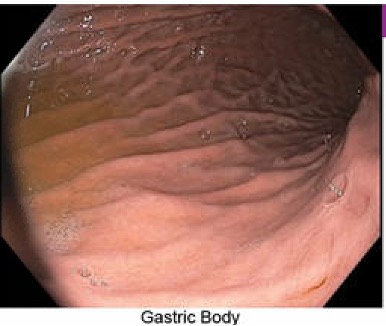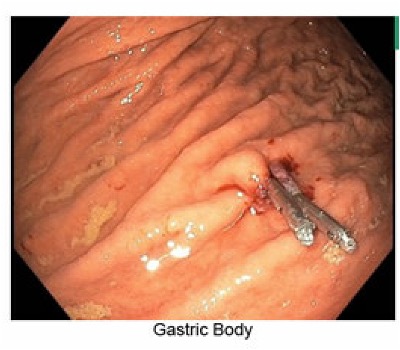Sunday Poster Session
Category: Interventional Endoscopy
P1446 - Unmasking a Hidden Risk: Delayed Gastric Bleeding Post-EUS Liver Biopsy in a Cirrhotic Kidney Transplant Candidate
Sunday, October 26, 2025
3:30 PM - 7:00 PM PDT
Location: Exhibit Hall

Keila Gabriela Carrera, MD (she/her/hers)
DHR Health
Edinburg, TX
Presenting Author(s)
Keila Gabriela. Carrera, MD1, Juan Sanchez, MD2, Carlos Cardenas, MD2
1DHR Health, Edinburg, TX; 2Doctors Hospital at Renaissance, Edinburg, TX
Introduction: Liver biopsy in essential for diagnosing many liver disease. Endoscopic ultrasound liver biopsy (EUS-LB) has emerged as a minimally invasive alternative to the traditional percutaneous or transjugular liver biopsy technique (TJLB). EUS-LB facilitates access to both the lobes of the liver and allows measurement of portal pressure.Most complications include abdominal pain, subcapsular hematoma, acute pancreatitis, infectious complications, and bile leak. Overall bleeding rates range from 0.13% to 0.9%, with most cases involving mild, self-limited bleeding that rarely requires intervention.
Case Description/
Methods: We present the case of a 37-year-old male with end-stage renal disease (ESRD) secondary to hypertension, who is on hemodialysis. He underwent EUS-guided liver biopsy with fine-needle aspiration (FNA) using a 19-gauge Boston Scientific Acquire needle.
As part of the kidney transplant eligibility evaluation, samples were obtained from the right and left hepatic lobes by passing through the stomach and duodenal bulb.Patient was discharged stable without complications after procedure.
However, three days later, he presented to the ED with melena, hematemesis, and a hemoglobin level of 5 g/dL. He also reported missing two hemodialysis sessions. Two units of PRBCs were transfused, and urgent hemodialysis was performed. An emergent esophagogastroduodenoscopy (EGD) revealed two discrete puncture sites with active bleeding, which was unmasked by water irrigation,consistent with previous biopsy sites. Endoclips and PuraStat application achieved hemostasis. Histopathology confirmed hepatocellular cirrhosis
Discussion: EUS-FNB has a relatively low complication rate of 0.03% to 0.15%, with bleeding representing approximately 1.2% of all complications. A near-fatal case of hemorrhagic shock following EUS-FNB was reported in Quebec, Canada.
Advanced kidney disease with consequent platelet dysfunction may be a risk factor for such bleeding. This case highlights the importance of remaining vigilant to the potential of delayed gastrointestinal bleeding secondary to platelet impairment in the setting of azotemia.

Figure: Gastric body before procedure

Figure: Gastric body after procedure
Disclosures:
Keila Carrera indicated no relevant financial relationships.
Juan Sanchez indicated no relevant financial relationships.
Carlos Cardenas indicated no relevant financial relationships.
Keila Gabriela. Carrera, MD1, Juan Sanchez, MD2, Carlos Cardenas, MD2. P1446 - Unmasking a Hidden Risk: Delayed Gastric Bleeding Post-EUS Liver Biopsy in a Cirrhotic Kidney Transplant Candidate, ACG 2025 Annual Scientific Meeting Abstracts. Phoenix, AZ: American College of Gastroenterology.
1DHR Health, Edinburg, TX; 2Doctors Hospital at Renaissance, Edinburg, TX
Introduction: Liver biopsy in essential for diagnosing many liver disease. Endoscopic ultrasound liver biopsy (EUS-LB) has emerged as a minimally invasive alternative to the traditional percutaneous or transjugular liver biopsy technique (TJLB). EUS-LB facilitates access to both the lobes of the liver and allows measurement of portal pressure.Most complications include abdominal pain, subcapsular hematoma, acute pancreatitis, infectious complications, and bile leak. Overall bleeding rates range from 0.13% to 0.9%, with most cases involving mild, self-limited bleeding that rarely requires intervention.
Case Description/
Methods: We present the case of a 37-year-old male with end-stage renal disease (ESRD) secondary to hypertension, who is on hemodialysis. He underwent EUS-guided liver biopsy with fine-needle aspiration (FNA) using a 19-gauge Boston Scientific Acquire needle.
As part of the kidney transplant eligibility evaluation, samples were obtained from the right and left hepatic lobes by passing through the stomach and duodenal bulb.Patient was discharged stable without complications after procedure.
However, three days later, he presented to the ED with melena, hematemesis, and a hemoglobin level of 5 g/dL. He also reported missing two hemodialysis sessions. Two units of PRBCs were transfused, and urgent hemodialysis was performed. An emergent esophagogastroduodenoscopy (EGD) revealed two discrete puncture sites with active bleeding, which was unmasked by water irrigation,consistent with previous biopsy sites. Endoclips and PuraStat application achieved hemostasis. Histopathology confirmed hepatocellular cirrhosis
Discussion: EUS-FNB has a relatively low complication rate of 0.03% to 0.15%, with bleeding representing approximately 1.2% of all complications. A near-fatal case of hemorrhagic shock following EUS-FNB was reported in Quebec, Canada.
Advanced kidney disease with consequent platelet dysfunction may be a risk factor for such bleeding. This case highlights the importance of remaining vigilant to the potential of delayed gastrointestinal bleeding secondary to platelet impairment in the setting of azotemia.

Figure: Gastric body before procedure

Figure: Gastric body after procedure
Disclosures:
Keila Carrera indicated no relevant financial relationships.
Juan Sanchez indicated no relevant financial relationships.
Carlos Cardenas indicated no relevant financial relationships.
Keila Gabriela. Carrera, MD1, Juan Sanchez, MD2, Carlos Cardenas, MD2. P1446 - Unmasking a Hidden Risk: Delayed Gastric Bleeding Post-EUS Liver Biopsy in a Cirrhotic Kidney Transplant Candidate, ACG 2025 Annual Scientific Meeting Abstracts. Phoenix, AZ: American College of Gastroenterology.

